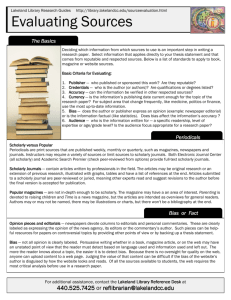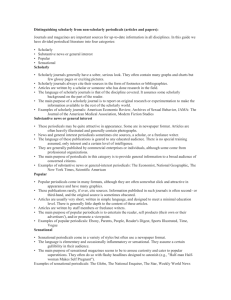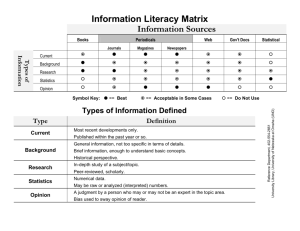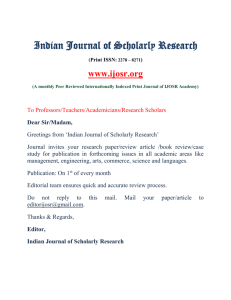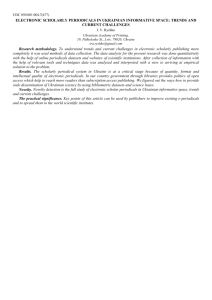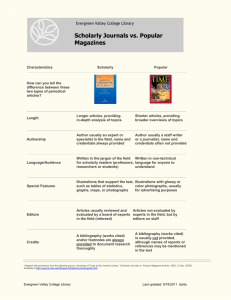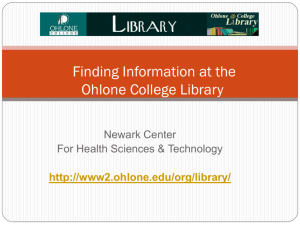Handout on Critically Analyzing Information Sources (Word Doc)
advertisement
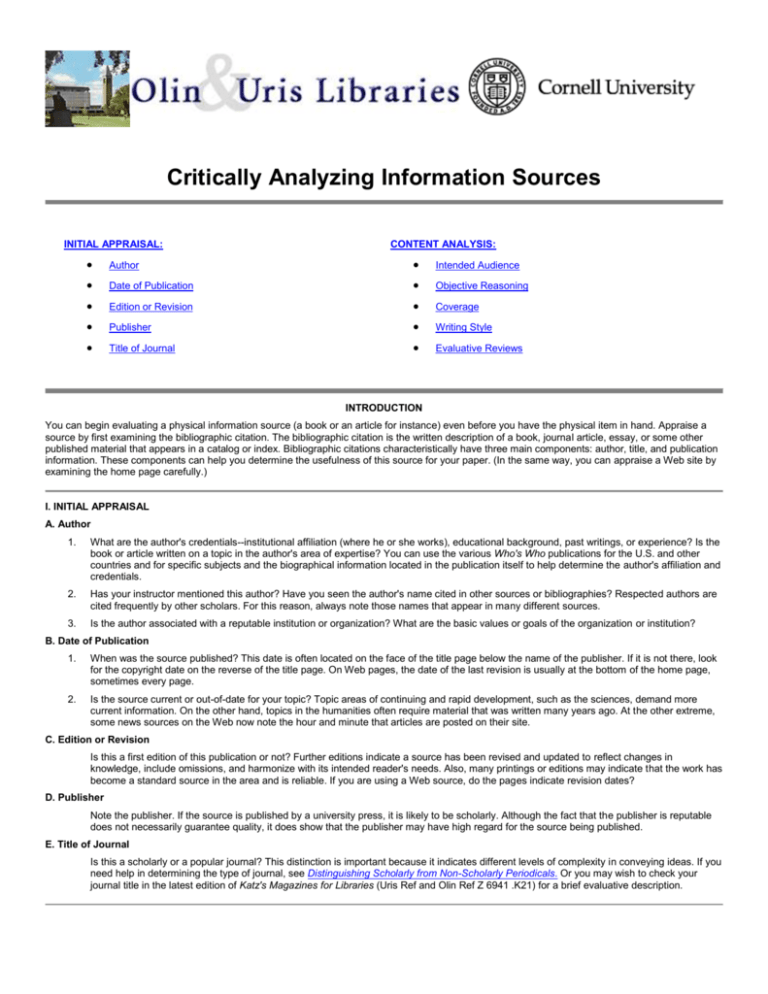
Critically Analyzing Information Sources INITIAL APPRAISAL: CONTENT ANALYSIS: Author Intended Audience Date of Publication Objective Reasoning Edition or Revision Coverage Publisher Writing Style Title of Journal Evaluative Reviews INTRODUCTION You can begin evaluating a physical information source (a book or an article for instance) even before you have the physical item in hand. Appraise a source by first examining the bibliographic citation. The bibliographic citation is the written description of a book, journal article, essay, or some other published material that appears in a catalog or index. Bibliographic citations characteristically have three main components: author, title, and publication information. These components can help you determine the usefulness of this source for your paper. (In the same way, you can appraise a Web site by examining the home page carefully.) I. INITIAL APPRAISAL A. Author 1. What are the author's credentials--institutional affiliation (where he or she works), educational background, past writings, or experience? Is the book or article written on a topic in the author's area of expertise? You can use the various Who's Who publications for the U.S. and other countries and for specific subjects and the biographical information located in the publication itself to help determine the author's affiliation and credentials. 2. Has your instructor mentioned this author? Have you seen the author's name cited in other sources or bibliographies? Respected authors are cited frequently by other scholars. For this reason, always note those names that appear in many different sources. 3. Is the author associated with a reputable institution or organization? What are the basic values or goals of the organization or institution? B. Date of Publication 1. When was the source published? This date is often located on the face of the title page below the name of the publisher. If it is not there, look for the copyright date on the reverse of the title page. On Web pages, the date of the last revision is usually at the bottom of the home page, sometimes every page. 2. Is the source current or out-of-date for your topic? Topic areas of continuing and rapid development, such as the sciences, demand more current information. On the other hand, topics in the humanities often require material that was written many years ago. At the other extreme, some news sources on the Web now note the hour and minute that articles are posted on their site. C. Edition or Revision Is this a first edition of this publication or not? Further editions indicate a source has been revised and updated to reflect changes in knowledge, include omissions, and harmonize with its intended reader's needs. Also, many printings or editions may indicate that the work has become a standard source in the area and is reliable. If you are using a Web source, do the pages indicate revision dates? D. Publisher Note the publisher. If the source is published by a university press, it is likely to be scholarly. Although the fact that the publisher is reputable does not necessarily guarantee quality, it does show that the publisher may have high regard for the source being published. E. Title of Journal Is this a scholarly or a popular journal? This distinction is important because it indicates different levels of complexity in conveying ideas. If you need help in determining the type of journal, see Distinguishing Scholarly from Non-Scholarly Periodicals. Or you may wish to check your journal title in the latest edition of Katz's Magazines for Libraries (Uris Ref and Olin Ref Z 6941 .K21) for a brief evaluative description. II. CONTENT ANALYSIS Having made an initial appraisal, you should now examine the body of the source. Read the preface to determine the author's intentions for the book. Scan the table of contents and the index to get a broad overview of the material it covers. Note whether bibliographies are included. Read the chapters that specifically address your topic. Scanning the table of contents of a journal or magazine issue is also useful. As with books, the presence and quality of a bibliography at the end of the article may reflect the care with which the authors have prepared their work. A. Intended Audience What type of audience is the author addressing? Is the publication aimed at a specialized or a general audience? Is this source too elementary, too technical, too advanced, or just right for your needs? B. Objective Reasoning 1. Is the information covered fact, opinion, or propaganda? It is not always easy to separate fact from opinion. Facts can usually be verified; opinions, though they may be based on factual information, evolve from the interpretation of facts. Skilled writers can make you think their interpretations are facts. 2. Does the information appear to be valid and well-researched, or is it questionable and unsupported by evidence? Assumptions should be reasonable. Note errors or omissions. 3. Are the ideas and arguments advanced more or less in line with other works you have read on the same topic? The more radically an author departs from the views of others in the same field, the more carefully and critically you should scrutinize his or her ideas. 4. Is the author's point of view objective and impartial? Is the language free of emotion-arousing words and bias? C. Coverage 1. Does the work update other sources, substantiate other materials you have read, or add new information? Does it extensively or marginally cover your topic? You should explore enough sources to obtain a variety of viewpoints. 2. Is the material primary or secondary in nature? Primary sources are the raw material of the research process. Secondary sources are based on primary sources. For example, if you were researching Konrad Adenauer's role in rebuilding West Germany after World War II, Adenauer's own writings would be one of many primary sources available on this topic. Others might include relevant government documents and contemporary German newspaper articles. Scholars use this primary material to help generate historical interpretations--a secondary source. Books, encyclopedia articles, and scholarly journal articles about Adenauer's role are considered secondary sources. In the sciences, journal articles and conference proceedings written by experimenters reporting the results of their research are primary documents. Choose both primary and secondary sources when you have the opportunity. D. Writing Style Is the publication organized logically? Are the main points clearly presented? Do you find the text easy to read, or is it stilted or choppy? Is the author's argument repetitive? E. Evaluative Reviews 1. Locate critical reviews of books in a reviewing source, such as Book Review Index, Book Review Digest, OR Periodical Abstracts. Is the review positive? Is the book under review considered a valuable contribution to the field? Does the reviewer mention other books that might be better? If so, locate these sources for more information on your topic. 2. Do the various reviewers agree on the value or attributes of the book or has it aroused controversy among the critics? 3. For Web sites, consider consulting one of the evaluation and reviewing sources on the Internet. Learning how to determine the relevance and authority of a given resource for your research is one of the core skills of the research process. For more assistance with the research process, consult your instructor or a reference librarian. Revised 06 October 2004 Originally Joan Ormondroyd; updated, edited and Webified by Michael Engle, and Tony Cosgrave http://www.library.cornell.edu/olinuris/ref/research/skill26.htm Conditions for the use of this Web page Noncommercial use: Permission is granted only for noncommercial uses. Olin and Uris Libraries, Cornell University, Ithaca NY 14853 IRIS: Instruction, Research & Information Services Information and reference: 607-255-4144, okuref@cornell.edu Circulation: (Olin) 607-255-4245, (Uris) 607-255-3537, olincirc@cornell.edu http://www.library.cornell.edu/olinuris/ref/research/skill26.htm Distinguishing Scholarly Journals from Other Periodicals Journals and magazines are important sources for up-to-date information in all disciplines. With a periodical collection as large and diverse as Cornell's it is often difficult to distinguish between the various levels of scholarship found in the collection. In this guide we have divided the criteria for periodical literature into four categories: Scholarly Substantive News/General Interest Popular Sensational DEFINITIONS: Webster'sThird International Dictionary defines scholarly as: 1) concerned with academic study, especially research, 2) exhibiting the methods and attitudes of a scholar, and 3) having the manner and appearance of a scholar. Substantive is defined as having a solid base, being substantial. Popular means fit for, or reflecting the taste and intelligence of, the people at large. Sensational is defined as arousing or intending to arouse strong curiosity, interest or reaction. Keeping these definitions in mind, and realizing that none of the lines drawn between types of journals can ever be totally clear cut, the general criteria are as follows. SCHOLARLY Scholarly journals generally have a sober, serious look. They often contain many graphs and charts but few glossy pages or exciting pictures. Scholarly journals always cite their sources in the form of footnotes or bibliographies. Articles are written by a scholar in the field or by someone who has done research in the field. The language of scholarly journals is that of the discipline covered. It assumes some scholarly background on the part of the reader. The main purpose of a scholarly journal is to report on original research or experimentation in order to make such information available to the rest of the scholarly world. Many scholarly journals, though by no means all, are published by a specific professional organization. EXAMPLES OF SCHOLARLY JOURNALS: American Economic Review Archives of Sexual Behavior JAMA: The Journal of the American Medical Association Journal of Marriage and the Family(published by the National Council on Family Relations) Modern Fiction Studies Sex Roles: A Journal of Research SUBSTANTIVE NEWS OR GENERAL INTEREST These periodicals may be quite attractive in appearance, although some are in newspaper format. Articles are often heavily illustrated, generally with photographs. News and general interest periodicals sometimes cite sources, though more often do not. Articles may be written by a member of the editorial staff, a scholar or a free lance writer. The language of these publications is geared to any educated audience. There is no specialty assumed, only interest and a certain level of intelligence. They are generally published by commercial enterprises or individuals, although some emanate from specific professional organizations. The main purpose of periodicals in this category is to provide information, in a general manner, to a broad audience of concerned citizens. EXAMPLES OF SUBSTANTIVE NEWS OR GENERAL INTEREST PERIODICALS: Christian Science Monitor Economist National Geographic New York Times Scientific American Vital Speeches of the Day POPULAR Popular periodicals come in many formats, although often somewhat slick and attractive in appearance. Lots of graphics (photographs, drawings, etc.). These publications rarely, if ever, cite sources. Information published in such journals is often second or third hand and the original source is sometimes obscure. Articles are usually very short, written in simple language and are designed to meet a minimal education level. There is generally little depth to the content of these articles. The main purpose of popular periodicals is to entertain the reader, to sell products (their own or their advertisers), and/or to promote a viewpoint. EXAMPLES OF POPULAR PERIODICALS: Ebony Parents People Weekly Readers Digest Sports Illustrated Time Vogue SENSATIONAL Sensational periodicals come in a variety of styles, but often use a newspaper format. Their language is elementary and occasionally inflammatory or sensational. They assume a certain gullibility in their audience. The main purpose of sensational magazines seems to be to arouse curiosity and to cater to popular superstitions. They often do so with flashy headlines designed to astonish (e.g. Half-man Half-woman Makes Self Pregnant). EXAMPLES OF SENSATIONAL PERIODICALS: Globe National Examiner Star Weekly World News FOR MORE INFORMATION ON INDIVIDUAL PERIODICAL TITLES There are reference books which describe and evaluate periodicals. For evaluations of specific periodicals, use: LaGuardia, Cheryl, ed., with Bill and Linda Sternberg Katz. Magazines for Libraries. 12th ed. New York: Bowker, 2003. (Uris Ref Z 6941 .K21 12th 2003; also Olin Ready Reference) An annotated listing by subject of over 6,000 periodicals. Each entry gives name of periodical, beginning publication date, publisher, editor, address, price and such information as indexing, size, and level of audience. Short abstracts describe the scope, political slant, and other aspects of the publication. Arrangement is topical, bringing magazines and journals on like subjects together. To find an individual title, use the title index at the end of the volume. Or ask for assistance at the reference desk. Revised 08 October 2004 Michael Engle Reference Department URL: http://www.library.cornell.edu/olinuris/ref/research/skill20.html Reference Department; Instruction, Research, and Information Services (IRIS); Cornell University Library, Ithaca, NY, USA Conditions for the use of this Web page Noncommercial use: Permission is granted only for noncommercial uses. Evaluating Web Sites: Criteria and Tools [ Context ] ~ [ Evaluation Criteria ] ~ [ Online Selection ] ~ [ Webliography ] Context: The Primary Factor The User Context: The most important factor when evaluating Web sites is your search, your needs. What are you using the Web for? Entertainment? Academic work? Hobbies or avocational interests? Scholarly sources are traditionally very strongly text-based. Compare the appearance and the content of an academic journal with a popular magazine. The Web Context: Some of the visual distinctions that signal the nature of content in print sources hold true on the Web as well, although, because the Web encourages wider use of graphics, Web versions of printed works usually contain more graphics and more color than their print counterparts. Color graphics appeared on the New York Times Web site before they appeared in the printed New York Times, for instance. Compare the Web versions of Child Abuse and Neglect (Cornell only), Mississippi Review (free to the public), The New York Times, U. S. News, and the National Enquirer. Evaluation Criteria --- Same as printed books and journals?: Critically Analyzing Information Sources from the Cornell University Library. Author Date of Publication Edition or Revision Publisher Title of Journal Intended Audience Objective Reasoning Coverage Writing Style Evaluative Reviews --- Evaluating Web Pages: Questions to Ask & Strategies for Getting the Answers: An eight-point evaluation checklist from the UC Berkeley Library. http://www.lib.berkeley.edu/TeachingLib/Guides/Internet/EvalForm_General_Barker.pdf What can the URL tell you? Who wrote the page? Is he, she, or the authoring institution a qualified authority? Is it dated? Current, timely? Is information cited authentic? Does the page have overall integrity and reliability as a source? What's the bias? Could the page or site be ironic, like a satire or a spoof? If you have questions or reservations, how can you satisfy them? --- Evaluating Information Found on the Internet from Johns Hopkins University (Elizabeth E. Kirk): Authorship Publishing body Point of view or bias Referral to other sources Verifiability Currency How to distinguish propaganda, misinformation and disinformation The mechanics of determining authorship, publishing body, and currency on the Internet --- Five Criteria for Evaluating Web Pages (Jim Kapoun): Accuracy Authority Currency Objectivity Coverage To evaluate Web sites go to this table of criteria and questions to ask when judging the reliability of information on the Web. --- Generic Criteria for Evaluation (Hope Tillman): Stated criteria for inclusion of information Authority of author or creator Comparability with related sources Stability of information Appropriateness of format Software/hardware/multimedia requirements --- ...Criteria for the Evaluation of Internet Information Resources (Alastair Smith) --- ICYouSee: T is for Thinking (John Henderson) Online Selection Examples: Subject Portals The Argus Clearinghouse ["no longer actively maintained"] BUBL Information Service The WWW Virtual Library Yahoo : Yahoo's Home Page and Yahoo's Magazines section Selection by librarians: Librarians' Index to the Internet [UC Berkeley] Internet Reference Resources [Cornell University] Webliography [Dates refer to the last dated revision seen] Alexander, Janet E. (Jan), and Marsha Ann Tate. Evaluating Web Resources [see "Original Evaluation Checklists" links]. (Widener University, PA; 25 July 2001) Barker, Joe, and Saifon Obromsook. Evaluating Web Pages: Questions to Ask & Strategies for Getting the Answers. (Library, University of California-Berkeley, 27 July 2004) Henderson, John R. The ICYouSee Critical Thinking Guide. (Ithaca College, NY; 11 November 2003) Kapoun, Jim. "Teaching Undergrads WEB Evaluation: A Guide for Library Instruction." C&RL News (July/August 1998): 522-523. Kirk, Elizabeth E. Evaluating Information Found on the Internet. (The Sheridan Libraries, Johns Hopkins University; 1996 copyright date). Smith, Alastair G. "Testing the Surf: Criteria for Evaluating Internet Information Resources." The Public-Access Computer Systems Review 8, no. 3 (1997). (Victoria University of Wellington, NZ; 1997 copyright date) Tillman, Hope. Evaluating Quality on the Net. (Babson College, MA; 28 March 2003) Revised 05 October 2004 URL http://www.library.cornell.edu/olinuris/ref/research/webeval.html Michael Engle moe1@cornell.edu Originally prepared for New York Library Association Conference, Saratoga Springs, NY, October 1996. Reference Department; Instruction, Research, and Information Services (IRIS); Cornell University Library, Ithaca, NY, USA Conditions for the use of this Web page Noncommercial use: Permission is granted only for noncommercial uses.
